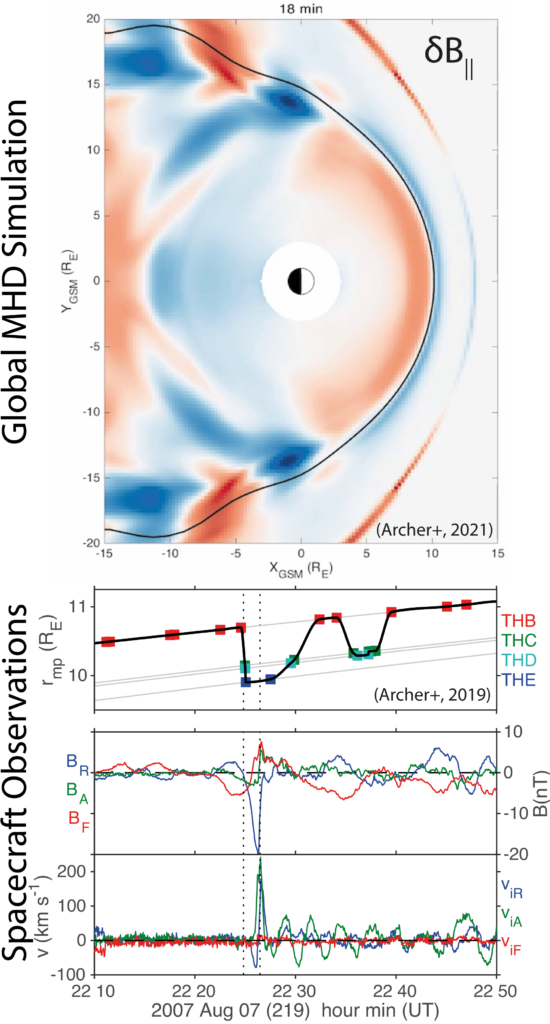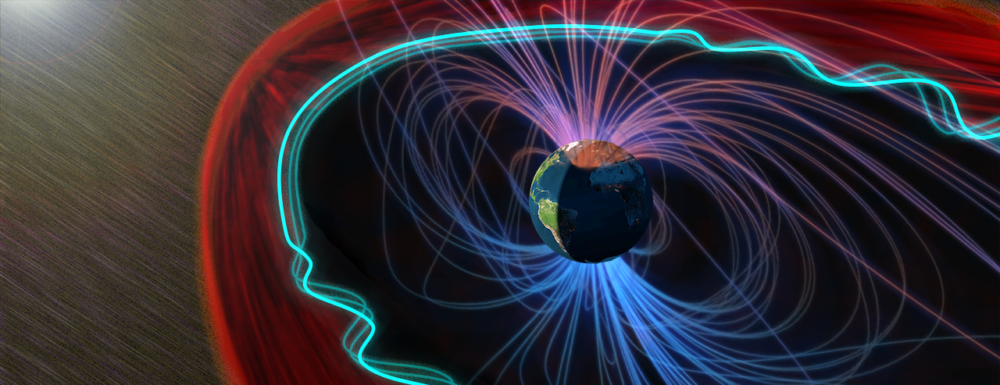Due to the great complexity and scope in understanding all mechanisms that lead to surface waves and their associated impacts in space plasma systems, the proposed ISSI team will address 4 main objectives.
Comprehensive review consolidating existing theory, simulations, & observations
Research into surface waves has been undertaken by unconnected groups and interdisciplinary study of these waves across the solar, heliospheric, and magnetospheric environments is rare (Nakariakov+, 2016). Among magnetospheric researchers, little connection has yet been drawn between the regimes of the surface eigenmodes and KHI generated waves. We will thus synthesise a comprehensive review of the state-of-the-art knowledge about surface waves in space plasmas. Analytic results from box, cylindrical, toroidal, and dipole models applied to different boundaries and environments will be compared to identify universal commonalities vs. situation-specific differences in the underpinning theory. Published simulation runs using different types of codes will be rationalised in terms of the consolidated theory. Finally, reported confirmed and candidate observational events at the plasmapause and magnetopause from a variety of local in situ spacecraft (e.g. Cluster, THEMIS, RBSP, MMS) as well as ground-based instruments (e.g. SuperDARN, magnetometers) will be compared to the existing simulations. Through the team’s expertise spanning these disparate boundaries, environments, regimes, and methods, this review will build a stronger holistic understanding of surface wave processes. It will piece together our current understanding of their generation, growth, properties, and impacts. It will also draw complementary parallels to/from other planetary systems, and heliospheric/coronal structures. Broader applications outside of heliophysics, such as laboratory tokamaks and astrophysical jets / accretion disks will be raised (Zhao+, 1992; Connor+, 1998; Stehle & Spruit, 1999). Such plasmas can only be remote sensed, hence the in situ measurements possible in the heliosphere will complement these fields. Our review will finally highlight outstanding and compelling science questions related to surface waves across the heliosphere and their respective impacts, in turn better equipping the team to undertake the novel research proposed in the following stages. Most materials/references will be collated before the 1st meeting.
Expected global connections & dynamics via simulations & statistical empirical models

We will employ the team’s different high-resolution global magnetospheric simulation codes to establish the global dynamics associated with surface waves, primarily focusing on the magnetopause. Challenge events will be selected, either from the literature or based on available spacecraft conjunctions, which cover different surface wave driving regimes (pressure-driven, KHI, reconnection, and combinations thereof). An example is shown to the right. Simulations will then be run with: A) real solar wind conditions during the challenge events; B) idealised synthetic runs to narrow down the physical processes occurring within the challenge events. Commonalities in the simulation results across distinct models will be found to lend confidence in their predictions. The wave properties will be compared to theory, as synthesised in the review, to confirm their nature as surface waves (rather than body modes) and reveal any differences present due to the more realistic conditions present. Because global MHD codes lack kinetic physics, we will also use the statistical empirical SAMU model (Dimmock and Nykyri, 2013; Ma+, 2020) to create maps for the challenge events of global plasma conditions that are relevant to instabilities known to also lead to surface wave growth.
From these results, we will develop new indirect detection methods for surface waves within observational data, able to eliminate other possible sources. Less-restrictive in situ criteria for spacecraft observations will be established, based purely on their ULF wave signatures deep within the magnetosphere. The poorly understood ground magnetic, ionospheric (radar, total electron content), and auroral (optical/ultraviolet) signatures of surface waves will also be determined, unveiling their nature in M-I coupling. Armed with these new techniques, predictions will be validated against observations during challenge events from multiple spacecraft (Cluster, THEMIS, MMS) which probe the different regions surface waves permeate as well as data from high-latitude facilities (magnetometer arrays, radar, all-sky imagers) in the Arctic and Antarctic. Once validated, the new methods will yield robust predictions for magnetopause surface wave observations that can be rolled out more widely for routine detection and characterisation.
The predictions for magnetopause surface waves at Earth will be generalised and validated, via case studies, for use at the plasmapause (He+, 2020) and the boundaries of other environments. For example, from confirmed auroral signatures at Earth we will apply solar expertise in wave imaging to assess HST images of Jupiter’s and Saturn’s aurorae in remote sensing magnetopause dynamics at these systems. Future observations in visible, ultraviolet, and soft X-ray imagery at Earth (e.g. SMILE) will also be evaluated.
Mine observations for magnetopause surface wave occurrence, properties & impacts
We will exploit existing databases of candidate magnetopause surface wave driving events available to the team (>40,000 events total, see Annex 1) to undertake large-scale statistics. By drawing upon the vast number of observation points now available from in situ space- (Cluster, GOES, MMS, RBSP, THEMIS) and ground-based (magnetometer, radar, imagery) instruments, we will apply our improved detection methods for each class of driving event (e.g. interplanetary shocks, magnetosheath jets) to ultimately determine:
- The occurrence rate of magnetopause surface waves, as a function of local time, under a variety of conditions, hence their efficiency in mediating SW-M-I coupling.
- Fundamental surface wave properties (frequency, wavelength, amplitude, growth rate) and how the conditions present (wave speed profiles, turbulence, reconnection etc.) affect these in a realistic way.
- The quantitative impacts that surface waves have on auroral, ionospheric, outer radiation belt, and trapped magnetospheric plasmas, thus their importance in the SW-M-I interaction.
This work will create statistical maps of magnetopause surface wave occurrence, properties, and impacts as a function of both external driving and internal plasma conditions, revolutionising our understanding of how the dynamics of a magnetosphere’s boundary dictates global mass, momentum and energy circulation.
Identify missing links & technology gaps required for solving unresolved questions
The international space physics community is preparing for the coming decades of space exploration through NASA’s Decadal survey and ESA’s M- and F-class mission call. Several mission concepts are in development concerning the impacts of meso-scale physical processes on global magnetospheric dynamics, which surface waves play a key role in. Our ISSI activities and papers will thus identify missing links that can be utilised by science committees and mission teams to drive science requirements and technology development. Our activities will also lead to development of new simulation tools and observational platforms.

